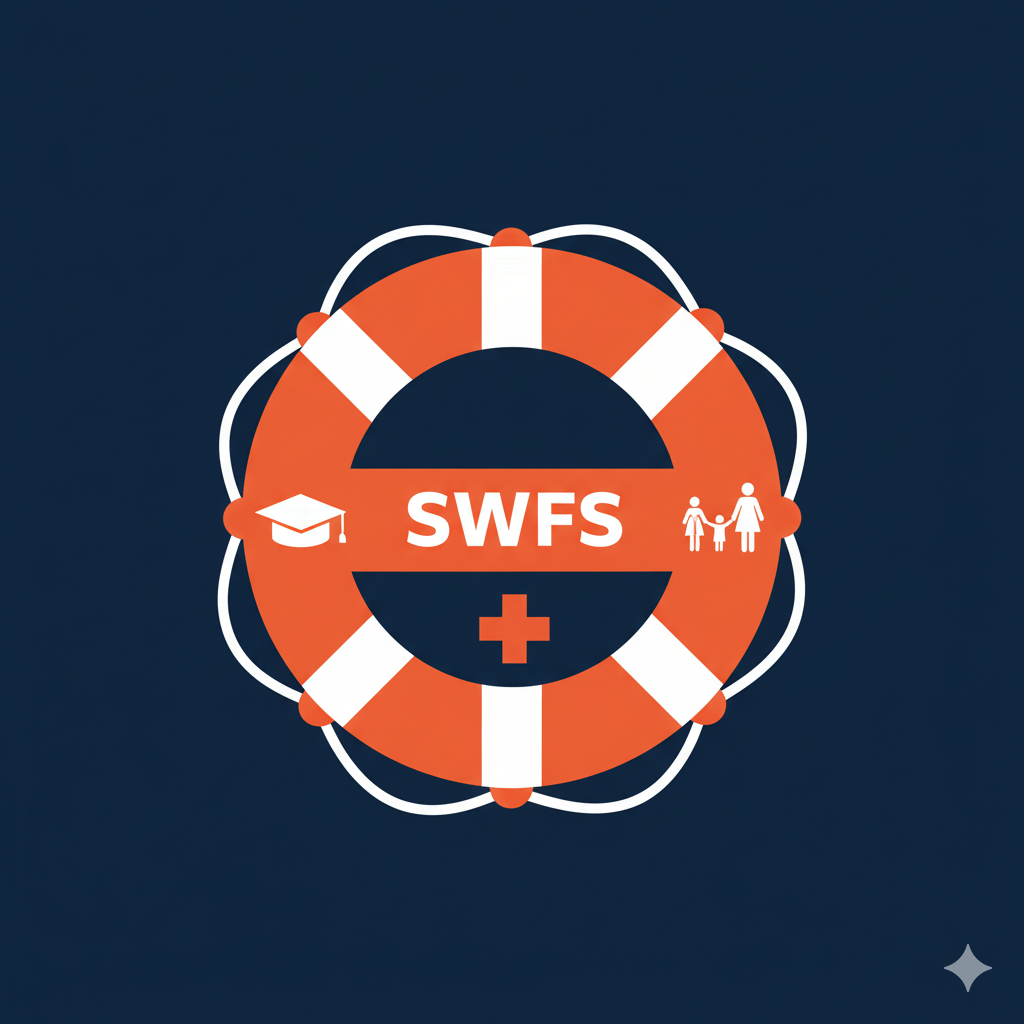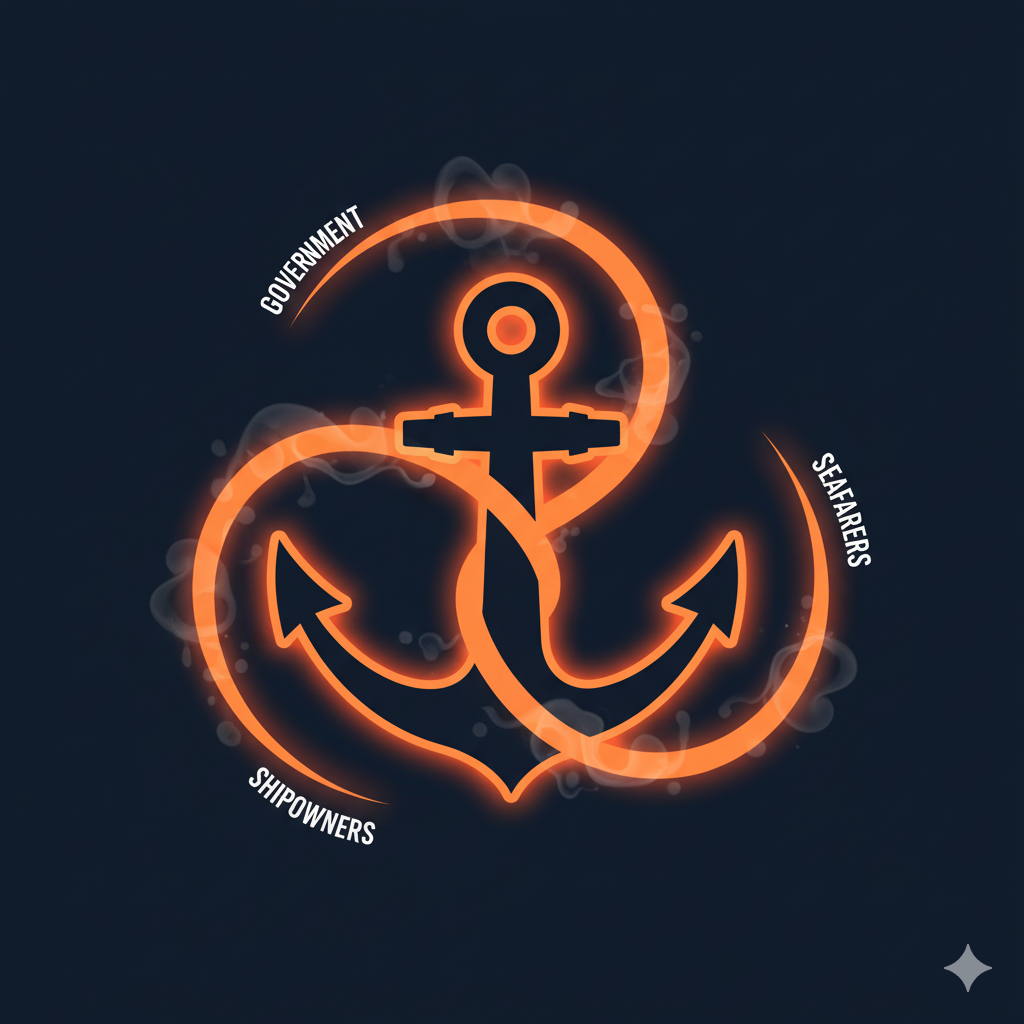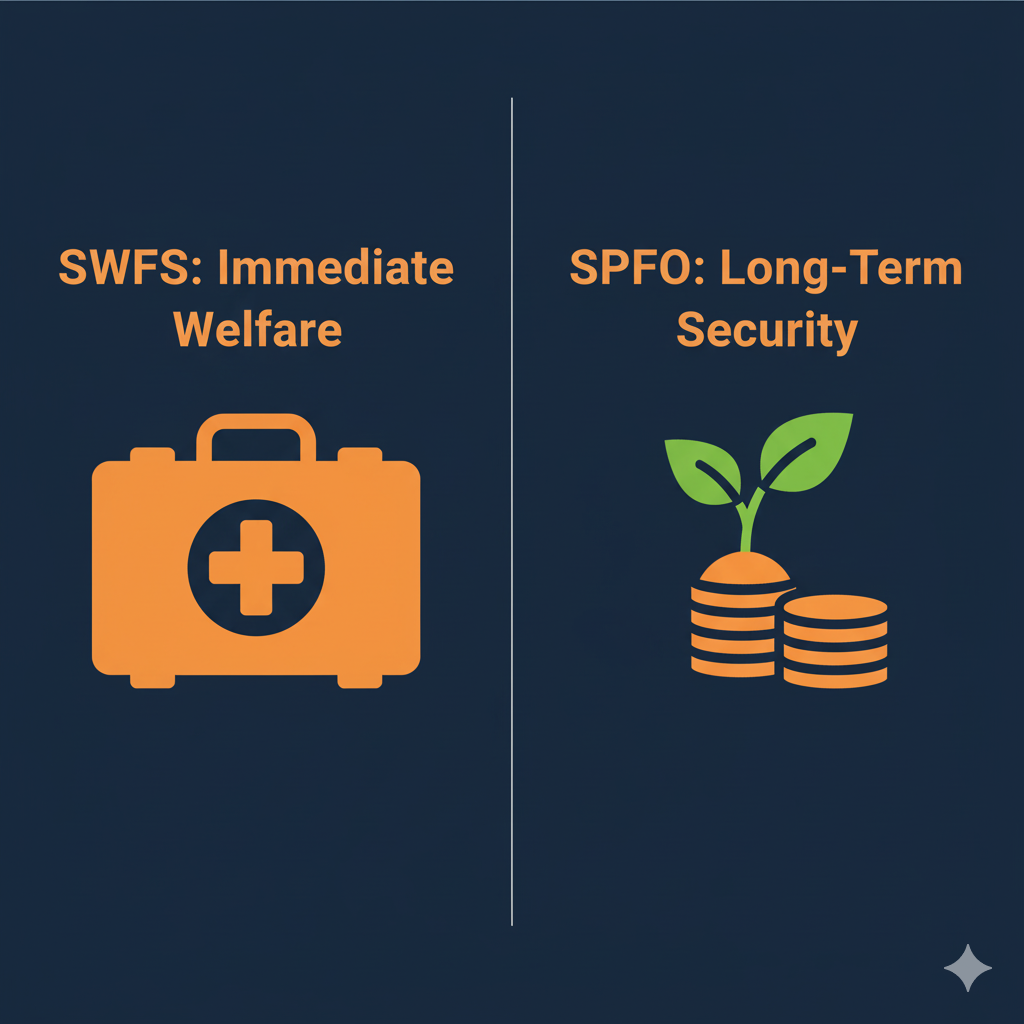Indian seafarers are the backbone of the global supply chain, but their financial security often goes unnoticed. What systems are in place to protect them and their families?
The two core pillars of financial protection are The Seafarers’ Welfare Fund Society (SWFS) for immediate needs and the Seamen’s Provident Fund Organisation (SPFO) for long-term security.
This guide will break down these complex systems, making it easy to understand the entire framework of seafarer welfare India. We believe that comprehensive knowledge about seafarer welfare India is crucial for every person in the maritime industry. This article is your definitive resource.

What is the Seafarers’ Welfare Fund Society (SWFS)?
The Seafarers’ Welfare Fund Society (SWFS) is a registered society established under the Societies Registration Act, 1860, and also registered as a Trust under the Bombay Public Trusts Act, 1950. Its primary function is to act as a safety net for Indian seafarers and their families. This society is a cornerstone of the seafarer welfare India program, functioning under the administrative control of the Directorate General of Shipping.
What are the core objectives of the SWFS for seafarer welfare in India?
The core objectives of the SWFS are multifaceted and designed to provide comprehensive support:
- To promote and implement a wide range of welfare schemes for Indian seafarers and their families.
- To manage funds collected under the Merchant Shipping Act, 1958, specifically for these welfare activities. The effective management of these funds is vital for
seafarer welfare India. - To provide financial aid related to education, health, housing, and death compensation.
- To coordinate with national and international welfare agencies and maritime bodies to improve the standards of seafarer welfare India, aligning with global maritime conventions.
- To offer emergency relief during natural calamities or industrial disasters affecting seafarers, as outlined in official DG Shipping circulars.
How is the SWFS structured and governed?
The society is governed by a board chaired by the Director General of Shipping (ex-officio). It includes representatives from the Ministry of Ports, Shipping and Waterways (MoPSW), seafarers’ unions, and shipowners, ensuring a tripartite approach to governance. This structure ensures balanced decisions for seafarer welfare India. The board also includes an Additional DG as Vice Chairman and a Deputy Director General of Shipping (Crew) as the Member Secretary.
Where does the SWFS get its funding from?
The financial strength of the SWFS comes from multiple sources, ensuring its ability to support seafarer welfare India initiatives. These include:
- Government grants.
- Contributions from shipping companies under Section 161 of the MS Act, 1958.
- Voluntary donations.
- Interest income and returns from investments.
Which Indian Seafarer Schemes Can You Access Through SWFS?

The SWFS operates several targeted Indian seafarer schemes designed to address specific needs. Understanding these schemes is key to leveraging the full benefits of the seafarer welfare India framework.
What educational assistance is available for seafarers’ children?
The Education Assistance Scheme supports the children of seafarers in pursuing education at various levels, including school (Class I-XII), undergraduate, postgraduate, and professional courses like Engineering and Medicine. To be eligible, the student must be the child of a registered Indian seafarer with an INDOS/CDC number. Benefits include scholarships ranging from ₹5,000 to ₹50,000, depending on the academic level and performance.
How does the medical assistance scheme support seafarers?
This scheme provides crucial financial aid for major medical treatments for seafarers and their families, covering life-threatening ailments such as cancer, heart surgery, dialysis, and organ transplants. Eligibility often requires certification from a DGS-approved medical examiner. A one-time support of up to ₹2,00,000 can be provided, offering a significant cushion during health crises. This is a practical example of seafarer welfare India in action.
What happens in the case of death or disability?
The Death and Disability Compensation Scheme offers financial relief to the families of seafarers who die or suffer total or partial disability due to their maritime service. This scheme acts as a crucial safety net, complementing preventative measures guided by standards for Occupational Health & Safety. The compensation amount can range from ₹2-5 lakh, depending on the nature of the incident. This scheme is a critical component of seafarer welfare India.
Is there any special assistance for women seafarers?
Yes, SWFS provides special support for Indian women seafarers during maternity, employment gaps, or other emergency conditions. This includes a maternity benefit of up to ₹50,000 and a temporary unemployment stipend for a maximum of six months. This initiative is a progressive step for seafarer welfare India.
How can stranded or abandoned seafarers get financial help?
In dire situations where Indian seafarers are abandoned abroad without salary or food, the SWFS offers an emergency support scheme. When a case is referred by DG Shipping or an Indian Mission , the fund can cover repatriation costs, food allowances, and legal aid. This demonstrates the responsive nature of the seafarer welfare India system.
How Does the Seamen’s Provident Fund Organisation (SPFO) Secure a Seafarer’s Future?

While SWFS handles immediate welfare, the SPFO is designed for long-term financial security. Established under The Seamen’s Provident Fund Act, 1966, it is the primary retirement savings vehicle and a vital part of seafarer welfare India.
What are the main roles of the SPFO in seafarer welfare in India?
The SPFO’s main role is to administer a provident fund for seafarers, ensuring they have a substantial corpus upon retirement. It is managed by a Board of Trustees with representatives from the government, employers, and seafarers. This tripartite board ensures that the management of SPFO contributions is fair and transparent, reinforcing the goals of seafarer welfare India.
How are SPFO contributions calculated and paid?
The process of SPFO contributions is straightforward. Both the seafarer and the employer contribute an equal amount. Since 1977, this rate has been set at 10% of the seaman’s wages from each party. The employer is responsible for depositing both shares into the fund and then recovering the employee’s share from their wages. This mandatory saving scheme ensures a disciplined approach to building a retirement fund, which is crucial for long-term seafarer welfare India.
When can a seafarer withdraw from their SPFO account?
Withdrawals are permitted under specific circumstances such as retirement, permanent disablement, or the death of the member. It is also possible to transfer the PF balance if a seaman permanently leaves the profession for a shore-based job covered under the EPF Act. These provisions make the SPFO a flexible yet secure tool for seafarer welfare India.
What protections are given to a seafarer’s SPFO funds?
The law provides strong protection for a member’s PF balance. The funds cannot be attached by legal processes to settle any debts or liabilities the seafarer might have. This ensures that the retirement savings remain secure, safeguarding the future of the seafarer and their family, a core principle of seafarer welfare India.
SPFO at a Glance: Key Features for Seafarers
| Governing Act | The Seamen’s Provident Fund Act, 1966. |
| Contribution Rate | An amount equal to 10% of wages from the seafarer, matched by a 10% contribution from the employer. |
| Withdrawal Conditions | Permitted upon retirement, permanent disablement, death, or transfer to an establishment under the EPF Act. |
| Legal Protection | The fund balance is protected from legal attachment for any debts or liabilities incurred by the seafarer. |
| Governance | Managed by a tripartite Board of Trustees, including representatives from the Central Government, employers, and seafarers. |
Who Governs the SWFS and SPFO Boards to Ensure Proper Seafarer Welfare in India?

The integrity of both the SWFS and SPFO hinges on their governance. The composition of their boards is designed to be representative and accountable, ensuring the mission of seafarer welfare India is always the top priority. The administration of these funds also aims to align with international standards for quality management to ensure transparency.
What is the composition of the SWFS Board?
The SWFS Board is chaired by the Director General of Shipping (ex-officio). Its members are a mix of ex-officio government officials and nominated representatives from MoPSW, Indian shipowners (including licensed RPSL agencies), seafarers’ unions (for both ratings and officers), and foreign shipowner associations. This ensures all stakeholders have a voice in shaping seafarer welfare India.
How is the SPFO Board of Trustees constituted?
The SPFO Board is also a tripartite body, constituted under the SPFO Act, 1966. It is headed by a Chairman appointed by the Central Government and includes other government representatives. Crucially, it also has representatives from employers (shipowners) and employees (seafarers), ensuring that the interests of those making SPFO contributions are directly represented in all policy decisions.
SWFS vs. SPFO: Board Governance Compared
| Feature | Seafarers’ Welfare Fund Society (SWFS) | Seamen’s Provident Fund Organisation (SPFO) |
| Legal Basis | Societies Registration Act, 1860. | The Seamen’s Provident Fund Act, 1966. |
| Head of Board | Director General of Shipping (ex-officio Chairman). | Chairman appointed by the Central Government. |
| Key Members | Representatives from MoPSW, shipowners, and seafarers’ unions. | Up to three Government officials, three employer representatives, and three seafarer representatives. |
| Primary Role | Administering immediate welfare schemes (education, health, etc.). | Administering the long-term provident fund for retirement. |
Ending Note: Why Do These Welfare Systems Matter?
The dual framework of the SWFS and SPFO provides a robust safety net, addressing both the immediate crises and long-term financial goals of Indian seafarers. From a child’s education to a secure retirement, these systems are a testament to the structured approach towards seafarer welfare India. They are not just funds; they are a promise of support and dignity to the professionals who keep our world moving. As the industry evolves, the commitment to enhancing seafarer welfare India remains a paramount objective, and if you need further guidance, you can always contact us to ensure that our seafarers are as well-cared for as the precious cargo they carry.
How do I apply for an SWFS education scholarship for my child?
You need to submit an application form with academic transcripts and your seafarer documents (like INDOS and CDC) to the SWFS. The process is managed through the DG Shipping/SWFS portals.
What is the current contribution rate for the SPFO?
The contribution rate is 10% of a seaman’s wages, with both the employer and the seafarer contributing an equal amount.
Can I get financial help from SWFS if I am abandoned by my employer in a foreign country?
Yes, the SWFS has a scheme to provide emergency support to Indian seafarers abandoned abroad. This support can include repatriation costs, food allowance, and legal aid. The case must be referred by DG Shipping or an Indian Mission to be eligible.
Are my SPFO savings protected from my personal debts?
Yes, the balance in a member’s SPFO account is legally protected from attachment for any debts or liabilities, ensuring your retirement fund remains secure.

